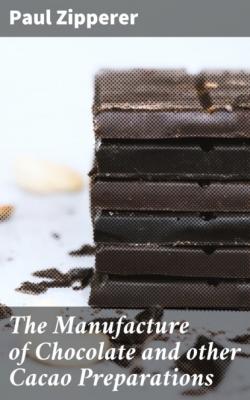ТОП просматриваемых книг сайта:
The Manufacture of Chocolate and other Cacao Preparations. Paul Zipperer
Читать онлайн.Название The Manufacture of Chocolate and other Cacao Preparations
Год выпуска 0
isbn 4064066215453
Автор произведения Paul Zipperer
Жанр Языкознание
Издательство Bookwire
Paul Zipperer
The Manufacture of Chocolate and other Cacao Preparations
Published by Good Press, 2019
EAN 4064066215453
Table of Contents
B. Chemical Constitution of the Bean.
Part II. The Manufacture of Cacao Preparations.
B. The Manufacture of Cocoa Powder and “Soluble” Cocoa.
C. Packing and Storing of the finished Cacao Preparations.
Part III. Ingredients used in the manufacture of chocolate.
A. Legal enactments. Condemned ingredients.
Part IV. Examination and Analysis of Cacao Preparations.
A. Chemical and microscopical examination of cacao and cacao preparations.
B. Definitions of Cacao Preparations.
A. Installation of a chocolate and cacao powder factory.
D. Authors. Alphabetical index.
Part I.
The Cacao Tree.
A. Tree and Beans.
a) Description of the Cacao Tree and its Fruit.
The cacao tree with its clusters of red blossom and golden yellow fruits is conspicuous even in tropical vegetation. Of considerable diameter at the base, it often attains a height of eight metres. Its wood is porous and light; the bark is cinnamon coloured, the simply alternating leaves are from 30 to 40 cm. in length and from 10 to 12 cm. broad, growing on stalks about 3 cm. long. The upper surface of these leaves is bright green, and the other one of a duller colour, and slightly hairy.
The flowers, which are often covered with hairs, occur either singly or united in bunches not only on the thicker branches but also all along the trunk from the root upwards. (Fig. 1 A.)
The formation of the fruit takes place only from the flowers of the stem or thicker branches, and for a thousand flowers there is only one ripe fruit.
The flowers (fig. 1 B & C) are very small and of a reddish white colour. Calyx and corolla are five partite, the ten filaments are united at their base (fig. 1 G) and only half of them are developed to fruitful organs, such as bear pollen (fig. 1 J) in their four separate anther compartments (fig. 1 H).
The pistil is formed of five united carpels and bears in each of its five compartments eight ovules. (Fig. 1 E & F).
The fruit is at first green, and afterwards turns yellow, but with streaks and tints of red occurring; many varieties also are entirely crimson. Resembling our cucumber in size, shape and appearance (see fig. 2 A & B), it has a length of about 25 cm. and a diameter of 10 cm., and the thickness of its shell is from 15 to 20 mm. This shell is of rather softer consistency than that of the gourd, and has five deep longitudinal channels, with five others of less depth between them.
Fig. 1. (After Berg & Schmidt, Atlas.)
A Twig in bloom (½). B Flower (3/1). C Flower in vertical section (3/1). D Leaf of flower (6/1) E Bean-pod in vertical section (6/1) F Bean-pod in cross section (9/1). H Anther. J Pollen.
The shell encloses a soft, sweetish pulp, within which from twenty-five to forty almond shaped seeds are ranged in five longitudinal rows, close to each other. The white colour of these seeds is frequently tinged with yellow, crimson, or violet (Sec. Fig. 2 C. D. & G).
Fig. 2. (After Berg & Schmidt).
A Fruit with half of shell removed (½). B Fruit in cross section (½). C Side view of seed (⅓). D Front view of seed (1/1). E Seedling (1/1). F Kotyledon or Seed-leaf (1/1). G Seed in cross section (1/1).
The fruits ripen throughout the whole year, though but slowly during the dry season; and the time needed for its full development is about four months. It may be gathered at all times of the year, although there are regular gathering seasons, determined and modified by the respective climatic conditions. So, for example, we find that in Brazil the principal gathering takes place in February and July, whilst in Mexico it is in March and April. In the primeval Amazonian forests the fruit of the cacao tree is gathered and brought to market at all times of the year, wherever Indian tribes obtain.
b) Geographical Distribution and History of the Cacao Tree.
The

